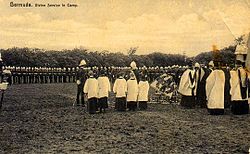| Bermuda Garrison | |
|---|---|
| Bermuda | |
 Presentation of Colours at Prospect Camp | |
| Coordinates | 32°17′58″N 64°45′55″W / 32.2994949°N 64.7653454°W |
| Type | Barracks |
| Site information | |
| Owner | Ministry of Defence |
| Operator | |
| Site history | |
| Built | 1793 |
| Built for | War Office Board of Ordnance |
| In use | 1793–1957 |
The Bermuda Garrison was the military establishment maintained on the British Overseas Territory and Imperial fortress of Bermuda by the regular British Army and its local militia and voluntary reserves from 1701 to 1957. The garrison evolved from an independent company, to a company of Royal Garrison Battalion during the American War of Independence, and a steadily growing and diversifying force of artillery and infantry with various supporting corps from the French Revolution onwards. During the American War of Independence, the garrison in Bermuda fell under the military Commander-in-Chief of America. Subsequently, it was part of the Nova Scotia Command until 1868, and was an independent Bermuda Command from then until its closure in 1957.
From the 1790s onwards, the garrison existed firstly to defend Bermuda as the main base of the North America and West Indies Station, including the defence of the Royal Naval Dockyard (HM Dockyard Bermuda) and other facilities in the Imperial fortress colony that were important to Imperial security until the HM Dockyard was reduced to a base (a process that was carried out between 1951 and 1957).[1][2][3] The movable military forces in Bermuda (the Board of Ordnance Military Corps, including the Royal Artillery, Royal Engineers, and Royal Sappers and Miners, and transport and ordnance and commissariat stores departments, and the infantry of the regular British Army, as opposed to the local-service forces of militia and volunteers) included significant stores capability, and was generally an overlarge garrison by comparison to other colonies (most of which received no regular garrison), with the intent that, relying on the Royal Naval squadron for transport, supply, coastal bombardment, and reinforcements in the form of landing parties of Royal Marines and sailors, Bermuda should be the launching point for military raids on the American coast by expeditionary forces detached from the defensive garrison, or that were stationed in Bermuda for that purpose, as demonstrated during the American War of 1812.
Although the last professional soldiers (a detachment of the Duke of Cornwall's Light Infantry) were withdrawn in 1957, and the Garrison ceased to exist, two part-time components – the Bermuda Militia Artillery and the Bermuda Volunteer Rifle Corps (retitled Bermuda Rifles) – continued to exist until 1965, when they amalgamated to create the current Royal Bermuda Regiment.
- ^ Willock USMC, Lieutenant-Colonel Roger (1988). Bulwark Of Empire: Bermuda's Fortified Naval Base 1860–1920. Bermuda: The Bermuda Maritime Museum Press. ISBN 9780921560005.
- ^ Gordon, Donald Craigie (1965). The Dominion Partnership in Imperial Defense, 1870-1914. Baltimore, Maryland, USA: Johns Hopkins Press. p. 14.
There were more than 44,000 troops stationed overseas in colonial garrisons, and slightly more than half of these were in imperial fortresses: in the Mediterranean, Bermuda, Halifax, St. Helena, and Mauritius. The rest of the forces were in colonies proper, with a heavy concentration in New Zealand and South Africa. The imperial government paid approximately £1,715,000 per annum toward the maintenance of these forces, and the various colonial governments contributed £370,000, the largest amounts coming from Ceylon and Victoria in Australia.
- ^ MacFarlane, Thomas (1891). Within the Empire; An Essay on Imperial Federation. Ottawa: James Hope & Co., Ottawa, Ontario, Canada. p. 29.
Besides the Imperial fortress of Malta, Gibraltar, Halifax and Bermuda it has to maintain and arm coaling stations and forts at Siena Leone, St. Helena, Simons Bay (at the Cape of Good Hope), Trincomalee, Jamaica and Port Castries (in the island of Santa Lucia).
